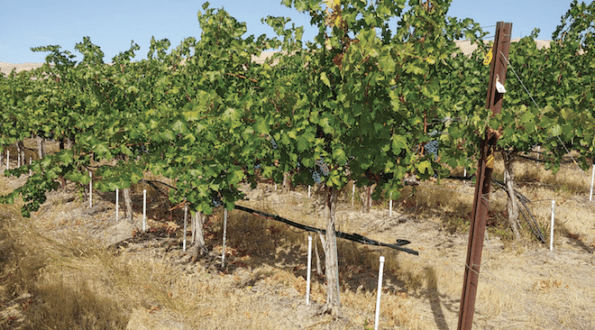
Jun 17, 2020Watering techniques come from Washington winegrapes
New techniques for irrigating winegrapes with less water and for higher quality are being developed by Washington State University (WSU) researchers.
Second only to California in winegrapes’ growing, Washington cultivates roughly 60,000 acres. While most of the state’s 1,000 licensed wineries are in or near the greater Seattle area, the vast majority of vineyards are east of the Cascade mountains and are heavily reliant on irrigation. To find irrigation techniques best suited to its unique region, the wine industry in the state has continued to fund research.
Conserving precious irrigation water and increasing grapes quality are priorities for the state.
“Most of the vineyards are irrigated, but that irrigation really gives the grower complete control,” said Washington State Wine Commission Research Program Director Melissa Hansen.
Rootzone sub-irrigation
Research for watering replacement vines was one new project among a record $1.2 million of grants funded by the state’s wine industry for the fiscal year that starts in July.
“I know the industry, they really struggle with the replant situation where you didn’t replant the entire vineyard, you just had replanted just a few trees or vines,” Hansen said. “You always struggle getting them established, because they’re competing against these fully-grown, big root systems.”
The trial is looking at a new watering technique developed by Pete W. Jacoby, a professor and plant ecologist at WSU’s Pullman campus.
“He explored putting PVC tubes in pipes down to the roots of the vine, and then putting an irrigation spaghetti tube in that PVC tube, so you’re actually putting water right to the root zone,” Hansen said. “And he calls it, ‘direct rootzone sub-irrigation.’”
Jacoby said he’s been perfecting the system for several years. He said some previous attempts at sub-irrigation had failed because either the lines would clog up, or the softer plastic would be chewed by the local rodents (Belding’s ground squirrels, aka sage rats). The PVC pipes though, protect the irrigation tubing.
The first-year study had involved basic proof of concept – seeing how vines with the system faired at 60%, 30% and even 15% of the water typically used in vineyards for surface drip irrigations. Trials the first year showed it was possible to get 70% of the yield of grapes using only 15% of the water.
“Now, those vines looked a little sparse in the canopy and the grapes were small, yet they suggested that they might have higher quality,” he said. They could get 90% of the yield at the highest treatment using 60% of the water.
In 2016 and 2017, trials showed how the stress on the vine affected quality. Reduced yields showed improvement in higher Brix or sugar content, increased tannins, lower acidity and, in the red grapes, higher anthocyanins – flavonoid pigments linked with health benefits.
“That was just because the grapes were smaller,” Jacoby said. “The color was more concentrated in the skin.”
But the results were good news for the research.
“We could save at least a third of the water,” he said. Subsequent experiments have established where the “sweet spots” are with irrigating with direct rootzone sub-irrigation. He’s now in the process of commercializing the project and finding growers in Washington and other regions – California, Texas, Idaho and Oregon – who are interested in trying the product.
A recent research review was led Jacoby, with a colleague, to study direct rootzone sub-irrigation for replanted vines. One idea is that the system will help the young plants to concentrate their roots in a cone shape underneath the plant, rather than spreading out close to the surface.
Earlier experiments have shown that vine roots can find water sources, Jacoby said.
“This followed almost an exact quote from one of my advisory committee (members) – he said, ‘The vine will put its roots where the water is,’” Jacoby said. “And that has proved to be the point. With this subsurface irrigation, we can basically create a dry zone in the upper part of the soil surface that really doesn’t get that much moisture naturally through the summer. It’s getting its moisture at two feet or below. And so, by having that dry zone, we prevent the wicking effect for the evaporation effect that often occurs. We can be more efficient with that water. At the same time, the vine gets kind of trained into that source and it limits its roots to that upper part.”


Deficit irrigation
One technique that emerged about 20 years ago in Washington is called “deficit irrigation” – withholding water early in the area to effectively thin the canopy, Hansen said.
“If you can withhold water early on, you can control how big the canopy gets,” she said. WSU professor Marcus Keller over the last 15 years has continued to dial in the specifics of the technique for different winegrape cultivars.
While early research labeled winegrape varieties as either “water optimists” or “water pessimists” depending on how they responded to drought stress, Hansen said follow-up research by Keller and his graduate students has painted a more complex picture.
“You really can’t put them in little groups, and so you really have to pay attention to the variety and your soil type,” she said.
While the use of deficit irrigation in most red winegrape varieties is well-established, growers have discovered a difference between how the reds and whites react.
“You can get away with a little bigger canopy with the whites,” Hansen said, and many white winegrape varieties also need more water than most reds do.
Keller’s work has also worked on adapting the Australian technique of partial rootzone drying for Washington vineyards. The technique involves alternating which side of the plant’s root zone is watered.
“It has some of the same advantages of deficit irrigation, but they’re finding it works really well for white varieties,” Hansen said.
— Stephen Kloosterman, associate editor














